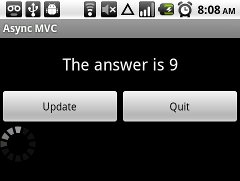
How do you separate application state, user interaction logic and data presentation in your Android apps?
Platform designers did not enforce any high-level application architecture framework upon us but left us enough options to implement our own solutions based on application requirements and scale. Most simple applications will get away with just storing data in their widgets (such as in text fields, spinners etc.) and their state manipulation right in event handlers such as OnClickListener‘s. However, if you are going to write a complex application or plan to sophisticate your simple app further, you should really think how to layer it well so that the architecture supports adding new features and satisfies the expected performance, flexibility, responsiveness and other requirements, and your code does not become a mess.
In this article, I will show you one practical approach to dividing application code into three layers according the MVC paradigm and connecting the view to the controller using the Android messaging framework. I used it in my own code and although it might not be 100% academically correct or applicable for every possible app, I love the benefits it gives to me as my app grows more and more complex.

